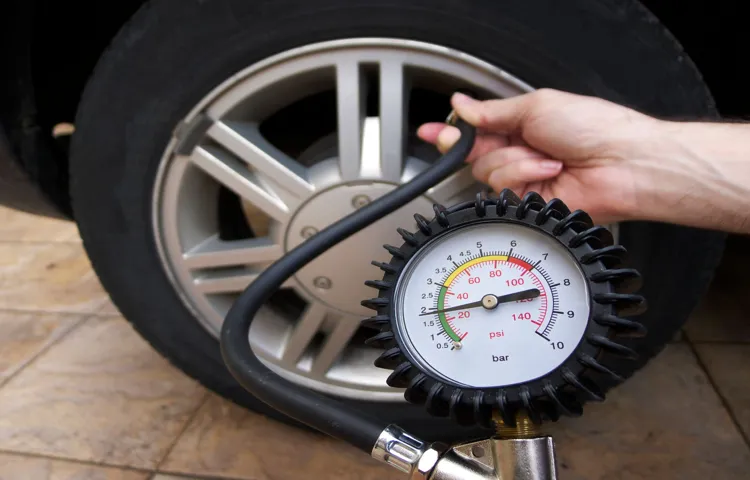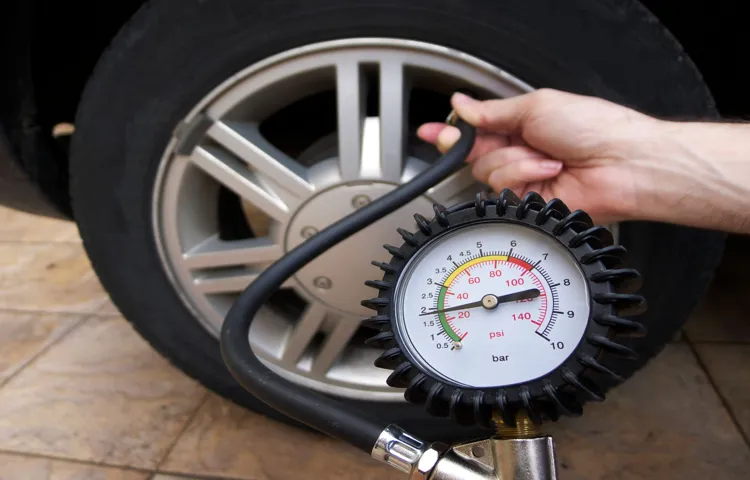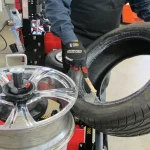Have you ever wondered why your tire keeps losing air even when you’re trying to fill it up? It can be frustrating, especially when you need to use your car, but it’s important to understand the underlying causes of this issue. There are a few reasons that could be causing your tire to continuously lose air, including punctures, valve stem damage, and even regular wear and tear. One common cause of tire deflation is punctures.
Sometimes, you may not even see a visible hole or object in your tire, but it could still be punctured. This can happen when driving on rough or rocky terrain, or even just from hitting a pothole. When air escapes through the puncture, it causes a slow leak and can lead to your tire losing air over time.
Another cause could be damage to the valve stem, which is the small protrusion from the tire that you attach the air hose to. If the valve stem is damaged, air can start to leak out from around it even when you are trying to fill up the tire. This issue is more prevalent in older vehicles or ones with rusted or corroded valve stems.
Lastly, normal wear and tear can also cause your tire to lose air over time. As tires age, the rubber can become brittle and crack, leading to small air leaks. This can be compounded by improper wheel alignment or overloading your vehicle, which can lead to uneven wear on your tires.
In any of these cases, it’s essential to have your tires inspected by a professional to maintain your safety on the road. Ignoring a leaking tire can lead to reduced performance, poor fuel efficiency, and even blowouts. So next time you find yourself struggling to fill up your tire, consider the possible causes and take action to prevent further damage.
Table of Contents
Possible Causes of Tire Deflation
If you find yourself wondering why your tire loses air when you try to fill it up, there are a few possible reasons that could explain the issue. One common cause of tire deflation is a puncture or tear in the tire’s sidewall or tread. This can happen when the tire hits a pothole or runs over sharp debris on the road.
Another potential reason for a tire to lose air is due to a faulty valve stem, which can become damaged over time or due to exposure to extreme temperatures. Additionally, corrosion or damage to the wheel rim can be another culprit for tire deflation. Finally, wear and tear to the tire, especially in older tires, can cause the rubber to break down and become more porous, leading to air leakage.
If you notice that your tire is consistently losing air, it’s important to get it inspected by a professional to ensure your safety on the road.
Punctured or Damaged Tire
A punctured or damaged tire can be a frustrating and potentially dangerous experience for any driver. There are many different causes of tire deflation, ranging from simple wear and tear to more serious issues like road debris or potholes. Potholes, in particular, can cause severe damage to tires, leaving them susceptible to punctures or blowouts.
Poor maintenance can also lead to tire deflation, such as not regularly checking tire pressure or failing to properly inflate tires. Additionally, extreme temperatures can cause tires to expand or contract, which can also lead to tire damage. Regardless of the cause, it is important to address tire deflation as soon as possible to prevent further damage and ensure the safety of all passengers on board.
If you suspect that your tire may be damaged, it is recommended to have it inspected by a professional mechanic to determine the extent of the damage and whether it is repairable or requires replacement.

Valve Stem Issues
Valve stem issues are one of the possible causes of tire deflation. A faulty valve stem can cause air to leak out of the tire, leading to unexpected flat tires. The valve stem functions like a gatekeeper to the tire, regulating air pressure and providing an entry point for inflating the tire.
Made of rubber or metal, a valve stem can wear out or sustain damage over time, resulting in leaks or ruptures. A common cause of valve stem issues is incorrect installation or over-torquing the valve, leading to damage and misalignment. Preventive measures like regular tire checks, proper installation, and replacing worn-out valve stems can help avoid these issues.
If you suspect a valve stem issue, it’s best to have a professional mechanic check your tires to prevent any further damage.
Leaking Valve or Wheel Rims
Tire deflation is a serious issue that every driver should be aware of. One of the most common causes of tire deflation is a leaking valve or wheel rim. This can happen due to a number of reasons, such as damage to the valve stem or corrosion on the wheel rim.
A leaking valve can cause the tire to lose air slowly over time, while a damaged wheel rim can cause a sudden loss of pressure. In either case, it’s important to get your tires checked regularly to avoid any potential safety risks. In addition to regular maintenance, it’s also important to be aware of any warning signs of tire deflation, such as a sudden loss of handling or a shaking sensation while driving.
By keeping an eye on your tires and addressing any issues early on, you can help ensure a safe and smooth driving experience. Remember, safety always comes first on the road.
Faulty Tire Pressure Gauge
The faulty tire pressure gauge can be a major cause of tire deflation. It can give you an inaccurate reading, causing you to not inflate the tires to the correct pressure. Other things that can cause tire deflation include punctures, damage to the tire wall, or even just natural leakage over time.
Proper tire inflation is crucial for your safety on the road, as underinflated tires can lead to poor handling, decreased fuel efficiency, and increased risk of blowouts. It’s important to regularly check your tire pressure with a working gauge, and to make sure any issues with punctures or damage are addressed promptly. Remember, when it comes to your safety while driving, you can never be too cautious.
How to Troubleshoot Tire Deflation Issues
Dealing with a tire that continually deflates can be frustrating and, at times, downright confusing. One minute, you’re adding air to the tire, and the next, it’s losing pressure again. The root cause of this problem can be related to several factors.
The most common issue many drivers face is a tire leak. Small punctures or tears in the tire wall could be causing air to escape slowly over time. Another possible culprit could be the valve system.
Dirt or debris buildup around the air valve or a faulty valve stem could disrupt air pressure and cause a loss of pressure. The weather and temperature changes can also contribute to tire deflation. Cold weather causes the air particles in the tire to contract, leading to less pressure, while warm weather causes air particles within the tire to expand, potentially leading to overinflation.
Always conduct a thorough inspection of your tire and valve system regularly, keeping an eye out for any potential leaks or other signs of damage. It is recommended to seek help from a professional mechanic if your tire continues to lose pressure, even after trying to fill it up.
Check for Visible Damage
When you discover that your tires are flat, the first step is to assess for visible damage. Check for any punctures or tears in the tire itself, as well as any damage to the valve stem or wheel. If there is no visible damage, try inflating the tire to the recommended pressure and see if it holds.
If not, the tire may have a slow leak or a damaged sidewall that is causing the air to escape. Alternatively, if you notice a bulge or bubble in the tire, it could be a sign of internal damage that needs to be addressed immediately. Remember to always have a spare tire on hand and to seek professional help if you are unsure of how to proceed.
By taking the time to troubleshoot your tire deflation issues, you can avoid potentially dangerous situations on the road.
Use a Tire Pressure Gauge
One important step in troubleshooting tire deflation issues is to use a tire pressure gauge. This handy tool helps you determine if your tires have lost pressure, which can often be the cause of deflation. Simply remove the valve cap from your tire and firmly press the gauge onto the valve stem.
The gauge will instantly display the pressure in the tire, allowing you to compare it to the recommended pressure for your vehicle. If the pressure is too low, you may need to inflate the tire to the proper level. Remember, tires that are not properly inflated can reduce fuel efficiency and wear out faster, so it’s important to check your pressure regularly.
By using a tire pressure gauge, you can take the first step in keeping your tires in top condition and preventing deflation issues.
Inspect the Valve Stem
If you’re having trouble with deflated tires, the valve stem could be to blame. The valve stem is a small component located on the tire that helps to regulate air pressure. Over time, the valve stem can become damaged or corroded, leading to air leaks and deflation issues.
To troubleshoot this problem, start by inspecting the valve stem for any signs of wear or damage. Look for cracks, tears, or corrosion, as these can all negatively impact the valve’s performance. If you notice anything unusual, it may be time to replace the valve stem.
Don’t let a faulty valve stem turn into a major problem – be proactive and address any issues as soon as you notice them! Keyword: tire deflation issues
Use Soapy Water to Find Leaks
If you have ever experienced the annoyance of a flat tire, you know the importance of being able to find a leak quickly and efficiently. One method that is frequently used is to submerge the tire in soapy water to identify where the air bubbles are escaping from. This technique is simple but effective, and it can be done in the comfort of your own home with just a bucket of water and some dish soap.
By pouring the soapy water over the tire and observing where the bubbles form, you can pinpoint the location of the leak and begin to troubleshoot why your tire is deflating. Whether it’s a puncture or a faulty valve stem, being able to quickly identify the problem can save you time and money in the long run. So next time you suspect a leaky tire, try the soapy water trick and see how easy it is to find and fix the issue!
Preventative Measures to Avoid Tire Deflation
Have you ever asked yourself, “why is my tire losing air when I try to fill it?”. This can be frustrating, but there are preventative measures you can take to avoid tire deflation. One of the most important things you can do is to regularly check your tire pressure with a tire gauge and fill them to the recommended level.
Overinflating your tires can cause them to wear more quickly and may lead to premature tire failure. Another way to prevent deflation is by keeping your tires properly aligned and rotated. Unaligned or irregularly worn tires may not maintain their proper pressure and can cause uneven wear and tear.
Lastly, avoiding road hazards such as potholes or debris can help prevent tire punctures and damage. By taking these preventative measures, you can avoid tire deflation and keep your tires in optimal condition, ensuring a safe and smooth driving experience. So next time you wonder, “why is my tire losing air when I try to fill it?”, remember to follow these simple tips and keep your tires in great shape.
Regular Tire Maintenance
As a responsible driver, regular tire maintenance should be on top of your priority list. One preventative measure you can take to avoid tire deflation is to regularly check your tire pressure. Underinflated tires can cause excessive heat buildup, leading to faster wear and tear and, in some cases, blowouts.
It’s also essential to check for any cuts, bulges, or other damages in your tires regularly. Punctures and cuts can lead to leaks, causing your tire to lose pressure slowly over time. Regular tire rotations can help ensure even wear across your tires, extending their lifespan.
By practicing these simple preventative measures, you can significantly reduce the likelihood of experiencing tire deflation while driving.
Avoid Obstacles on the Road
Driving on the road can be a daunting task, especially when there are obstacles along the way. One of the most common problems that drivers face is tire deflation or punctures, which can be dangerous and costly. However, there are several preventative measures that you can take to reduce the risk of experiencing tire deflation or punctures.
One of the simplest ways is to keep your tires properly inflated. This not only increases your vehicle’s fuel efficiency but also improves your overall driving experience. Additionally, it is crucial to avoid driving over debris or potholes on the road as this could cause damage to your tires.
If you notice any unusual vibration or noise while driving, it’s best to pull over and inspect your tires immediately. By taking these small precautions, you can keep your tires in good condition, prevent unexpected breakdowns, and ensure a safe and enjoyable driving experience.
Check Tire Pressure Regularly
It’s imperative to check your tire pressure regularly to avoid deflation and ensure a safer driving experience. Low tire pressure increases the risk of accidents and wears down tires more quickly, costing you money in the long run. You can easily check your tire pressure at home with a tire pressure gauge, and it only takes a few minutes.
Start by ensuring your tires are cool and remove the valve cap. Insert the gauge and press down until the hissing sound stops. The gauge should display the appropriate psi for your vehicle, which can be found in the owner’s manual or on the driver’s side door jamb.
If your tires need air, you can find a tire inflator at most gas stations or invest in one for home use. Regularly checking your tire pressure is a simple way to stay safe on the road and save money on tire replacements.
Conclusion
Well, if your tire is losing air when you try to fill it, the answer may not be so straightforward. It could be anything from a simple puncture to a mischievous gremlin who likes letting out air from tires. But more than likely, it’s a problem with your tire valve or even your own filling techniques.
Either way, don’t let this deflate your spirits! Keep persevering, and you’ll be back on the road in no time. And who knows, maybe next time you’ll even be able to outsmart that pesky tire gremlin!”
FAQs
What could be causing my tire to lose air when I fill it up?
There could be a few reasons why this is happening, such as a punctured tire, damaged valve stem, or a leaky wheel.
How can I determine if my tire has a puncture or leak?
You can inspect the tire for any visible damage, listen for any hissing sounds, or spray soapy water around the tire to look for bubbles.
Can I still drive on a tire that’s losing air?
It’s not recommended to drive on a tire that’s constantly losing air, as it can cause further damage and potentially lead to a blowout while driving.
Should I repair or replace a tire that’s losing air?
It depends on the severity of the damage and the age of the tire. A professional mechanic can assess the condition and recommend the best course of action.
How often should I check my tire pressure to prevent air loss?
It’s recommended to check your tire pressure at least once a month and before any long road trips to ensure proper inflation.
Can extreme temperatures affect tire pressure and cause air loss?
Yes, drastic temperature changes can cause tires to lose pressure, especially in cold weather. It’s important to check your tire pressure regularly during these conditions.
What type of tire maintenance can I do to prevent air loss?
Regular tire rotations, ensuring proper wheel alignment, and avoiding harsh road conditions can all help prevent tire damage and air loss.



